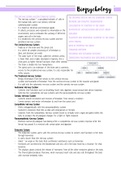Summary
Summary AQA A-Level Psychology Biopsychology Notes
- Course
- Institution
- Book
These are detailed notes for the Biopsychology Topic of AQA A-Level Psychology. I wrote them using class notes, revision guides and textbooks. I will also be uploading the other topics and creating bundles. Topics Included: - The Nervous System and the Endocrine System - Neurons and Synaptic T...
[Show more]




